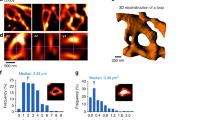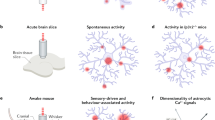Abstract
Astrocytes communicate with synapses by means of intracellular calcium ([Ca2+]i) elevations, but local calcium dynamics in astrocytic processes have never been thoroughly investigated. By taking advantage of high-resolution two-photon microscopy, we identify the characteristics of local astrocyte calcium activity in the adult mouse hippocampus. Astrocytic processes showed intense activity, triggered by physiological transmission at neighboring synapses. They encoded synchronous synaptic events generated by sparse action potentials into robust regional (∼12 μm) [Ca2+]i elevations. Unexpectedly, they also sensed spontaneous synaptic events, producing highly confined (∼4 μm), fast (millisecond-scale) miniature Ca2+ responses. This Ca2+ activity in astrocytic processes is generated through GTP- and inositol-1,4,5-trisphosphate–dependent signaling and is relevant for basal synaptic function. Thus, buffering astrocyte [Ca2+]i or blocking a receptor mediating local astrocyte Ca2+ signals decreased synaptic transmission reliability in minimal stimulation experiments. These data provide direct evidence that astrocytes are integrated in local synaptic functioning in adult brain.
This is a preview of subscription content, access via your institution
Access options
Subscribe to this journal
Receive 12 print issues and online access
$209.00 per year
only $17.42 per issue
Buy this article
- Purchase on Springer Link
- Instant access to full article PDF
Prices may be subject to local taxes which are calculated during checkout






Similar content being viewed by others
References
Halassa, M.M. & Haydon, P.G. Integrated brain circuits: astrocytic networks modulate neuronal activity and behaviour. Annu. Rev. Physiol. 72, 335–355 (2010).
Perea, G., Navarrete, M. & Araque, A. Tripartite synapses: astrocytes process and control synaptic information. Trends Neurosci. 32, 421–431 (2009).
Fellin, T. et al. Neuronal synchrony mediated by astrocytic glutamate through activation of extrasynaptic NMDA receptors. Neuron 43, 729–743 (2004).
Fiacco, T.A. et al. Selective stimulation of astrocyte calcium in situ does not affect neuronal excitatory synaptic activity. Neuron 54, 611–626 (2007).
Perea, G. & Araque, A. Astrocytes potentiate transmitter release at single hippocampal synapses. Science 317, 1083–1086 (2007).
Henneberger, C., Papouin, T., Oliet, S.H.R. & Rusakov, D.A. Long term potentiation depends on D-serine release from astrocytes. Nature 463, 232–236 (2010).
Agulhon, C., Fiacco, T.A. & McCarthy, K.D. Hippocampal short- and long-term plasticity are not modulated by astrocyte Ca2+ signaling. Science 327, 1250–1254 (2010).
Hamilton, N.B. & Attwell, D. Do astrocytes really exocytose neurotransmitters? Nat. Rev. Neurosci. 11, 227–238 (2010).
Nett, W.J., Oloff, S.H. & McCarthy, K.D. Hippocampal astrocytes in situ exhibit calcium oscillations that occur independent of neuronal activity. J. Neurophysiol. 87, 528–537 (2002).
Parri, H.R., Gould, T.M. & Crunelli, V. Spontaneous astrocytic Ca2+ oscillations in situ drive NMDAR-mediated neuronal excitation. Nat. Neurosci. 4, 803–812 (2001).
Hirase, H., Quian, L., Bartho', P. & Buzsàki, G. Calcium dynamics of astrocytic networks in vivo. PLoS Biol. 2, E96 (2004).
Nimmerjahn, A., Kirchhoff, F., Kerr, J.N.D. & Helmchen, F. Sulforhodamine 101 as a specific marker of astroglia in the neocortex in vivo. Nat. Methods 1, 31–37 (2004).
Wang, X. et al. Astrocytic Ca2+ signaling evoked by sensory stimulation in vivo. Nat. Neurosci. 9, 816–823 (2006).
Grosche, J. et al. Microdomains for neuron-glia interactions: parallel fiber signaling to Bergmann glial cells. Nat. Neurosci. 2, 139–143 (1999).
Yasuda, R. et al. Imaging calcium concentration dynamics in small neuronal compartments. Sci. STKE pl5, 219 (2004).
Zhou, M., Schools, G.P. & Kimelberg, H.K. Development of GLAST+ astrocytes and NG2(+) glia in rat hippocampus CA1: mature astrocytes are electrophysiologically passive. J. Neurophysiol. 95, 134–143 (2006).
Colonnese, M.T., Zhao, J.P. & Constantine-Paton, M. NMDA receptor currents suppress synapse formation on sprouting axons in vivo. J. Neurosci. 25, 1291–1303 (2005).
Trommald, M. & Hulleberg, G. Dimensions and density of dendritic spines from rat dentate granule cells based on reconstructions from serial electron micrographs. J. Comp. Neurol. 377, 15–28 (1997).
Wang, S.Y. & Wang, G.K. Voltage-gated sodium channels as primary targets of diverse lipid-soluble neurotoxins. Cell. Signal. 15, 151–159 (2003).
Zhou, Q., Petersen, C.C. & Nicoll, R.A. Effects of reduced vesicular filling on synaptic transmission in rat hippocampal neurones. J. Physiol. (Lond.) 525, 195–206 (2000).
Domercq, M. et al. P2Y1 receptor-evoked glutamate exocytosis from astrocytes: control by tumor necrosis factor-alpha and prostaglandins. J. Biol. Chem. 281, 30684–30696 (2006).
Jourdain, P. et al. Glutamate exocytosis from astrocytes controls synaptic strength. Nat. Neurosci. 10, 331–339 (2007).
Santello, M., Bezzi, P. & Volterra, A. TNFα controls glutamatergic gliotransmission in the hippocampal dentate gyrus. Neuron 69, 988–1001 (2011).
Ikeda, K. & Bekkers, J.M. Counting the number of releasable synaptic vesicles in a presynaptic terminal. Proc. Natl. Acad. Sci. USA 106, 2945–2950 (2009).
Rosenmund, C. & Stevens, C.F. Definition of the readily releasable pool of vesicles at hippocampal synapses. Neuron 16, 1197–1207 (1996).
Petravicz, J., Fiacco, T.A. & McCarthy, K.D. Loss of IP3Receptor-dependent Ca2+ increases in hippocampal astrocytes does not affect baseline CA1 pyramidal neuron synaptic activity. J. Neurosci. 28, 4967–4973 (2008).
Raastad, M., Storm, J.F. & Andersen, P. Putative single quantum and single fibre excitatory postsynaptic currents show similar amplitude range and variability in rat hippocampal slices. Eur. J. Neurosci. 4, 113–117 (1992).
Min, M.-Y., Asztely, F., Kokaia, M. & Kullmann, D.M. Long-term potentiation and dual-component quantal signaling in the dentate gyrus. Proc. Natl. Acad. Sci. USA 95, 4702–4707 (1998).
Wu, J. et al. NMDA receptor- and metabotropic glutamate receptor-dependent synaptic plasticity induced by high frequency stimulation in the rat dentate gyrus in vitro. J. Physiol. (Lond.) 533, 745–755 (2001).
Kang, J., Jiang, L., Goldman, S.A. & Nedergaard, M. Astrocyte-mediated potentiation of inhibitory synaptic transmission. Nat. Neurosci. 1, 683–692 (1998).
Navarrete, M. & Araque, A. Endocannabinoids mediate neuron-astrocyte communication. Neuron 57, 883–893 (2008).
Liu, Y.B., Lio, P.A., Pasternak, J.F. & Trommer, B.L. Developmental changes in membrane properties and postsynaptic currents of granule cells in rat dentate gyrus. J. Neurophysiol. 76, 1074–1088 (1996).
Goldberg, J.H., Tamas, G., Aronov, D. & Yuste, R. Calcium microdomains in aspiny dendrites. Neuron 40, 807–821 (2003).
Soler-Llavina, G.J. & Sabatini, B.L. Synapse-specific plasticity and compartmentalized signaling in cerebellar stellate cells. Nat. Neurosci. 9, 798–806 (2006).
Chao, T.I., Rickmann, M. & Wolff, J.R. The synapse-astrocyte boundary: an anatomical basis for an integrative role of glia in synaptic transmission. In The Tripartite Synapse: Glia in Synaptic Transmission (eds. Volterra, A., Magistretti, P.J. & Haydon, P.G.) 3–23 (Oxford Univ. Press, New York, 2002).
Bezzi, P. et al. Astrocytes contain a vesicular compartment that is competent for regulated exocytosis of glutamate. Nat. Neurosci. 7, 613–620 (2004).
Witcher, M.R., Kirov, S.A. & Harris, K.M. Plasticity of perisynaptic astroglia during synaptogenesis in the mature rat hippocampus. Glia 55, 13–23 (2007).
Matsui, K. & Jahr, C.E. Ectopic release of synaptic vesicles. Neuron 40, 1173–1183 (2003).
Murthy, V.N. & Stevens, C.F. Reversal of synaptic vesicle docking at central synapses. Nat. Neurosci. 2, 503–507 (1999).
Mori, M., Heuss, C., Gähwiler, B.H. & Gerber, U. Fast synaptic transmission mediated by P2X receptors in CA3 pyramidal cells of rat hippocampal slice cultures. J. Physiol. (Lond.) 535, 115–123 (2001).
Pankratov, Y., Lalo, U., Verkhratsky, A. & North, R.A. Quantal release of ATP in mouse cortex. J. Gen. Physiol. 129, 257–265 (2007).
Matyash, V., Filippov, V., Mohrhagen, K. & Kettenmann, H. Nitric oxide signals parallel fiber activity to Bergmann glial cells in the mouse cerebellar slice. Mol. Cell. Neurosci. 18, 664–670 (2001).
Bergersen, L.H. et al. Immunogold detection of L-glutamate and D-serine in small synaptic like microvesicles in adult hippocampal astrocytes. Cereb. Cortex (in the press).
Golovina, V.A. Visualization of localized store-operated calcium entry in mouse astrocytes. Close proximity to the endoplasmic reticulum. J. Physiol. (Lond.) 564, 737–749 (2005).
Doengi, M. et al. GABA uptake-dependent (Ca2+) signalling in developing olfactory bulb astrocytes. Proc. Natl. Acad. Sci. USA 106, 17570–17575 (2009).
Palygin, O., Lalo, U., Verkhratsky, A. & Pankratov, Y. Ionotropic NMDA and P2X1/5 receptors mediate synaptically induced Ca2+ signalling in cortical astrocytes. Cell Calcium 48, 225–231 (2010).
McKinney, R.A., Capogna, M., Dürr, R., Gähwiler, B.H. & Thompson, S.M. Miniature synaptic events maintain dendritic spines via AMPA receptor activation. Nat. Neurosci. 2, 44–49 (1999).
Sutton, M.A. et al. Miniature neurotransmission stabilizes synaptic function via tonic suppression of local dendritic protein synthesis. Cell 125, 785–799 (2006).
Ullian, E.M., Sapperstein, S.K., Christopherson, K.S. & Barres, B.A. Control of synapse number by glia. Science 291, 657–661 (2001).
Nolte, C. et al. GFAP promoter-controlled EGFP-expressing transgenic mice: a tool to visualize astrocytes and astrogliosis in living brain tissue. Glia 33, 72–86 (2001).
Acknowledgements
We thank P. Bezzi for experiments in cultured astrocytes and critical comments, K.D. McCarthy (University of North Carolina, Chapel Hill) and P.G. Haydon (Tufts University) for providing Itpr2−/− mice, H. Kettenmann (Max Delbrück Center) for providing GFAP-EGFP mice, V. Crunelli, R. Schneggenburger and F. Helmchen for suggestions, and T. Oertner for critical reading of a previous manuscript version. This work was supported by grants from Swiss National Science Foundation (3100A0–100850 and 3100A0–120398) to A.V.; J.C. received a postdoctoral fellowship from MBF Foundation, Triesen, LI/Synapsis Foundation, Zurich; P.T., from Swiss National Science Foundation National Center of Competence in Research 'Synapsy'. M.S. received a University of Lausanne Faculty of Biology and Medicine PhD fellowship.
Author information
Authors and Affiliations
Contributions
M.A.D.C. performed imaging, electrophysiology (including minimal stimulations) and data analysis; J.C. coordinated imaging, software development and performed imaging and data analysis; and the three next authors contributed equally: N.L. developed software for imaging data analysis and participated in imaging and imaging data analysis; K.B. performed imaging and electrophysiology and contributed to software development in the first part of the project; and M.S. performed imaging, electrophysiology and electrophysiology analysis. D.B. performed immunohistochemistry, P.T. performed imaging and data analysis in the last part of the project, and A.V. coordinated the project and wrote the manuscript.
Corresponding author
Ethics declarations
Competing interests
The authors declare no competing financial interests.
Supplementary information
Supplementary Text and Figures
Supplementary Figures 1–13, Supplementary Data 1 and 2 (PDF 722 kb)
Supplementary Video 1
Ca2+ activity in astrocytic processes in basal condition. Ca2+ imaging sequence (150 s, 3 Hz, accelerated 5 times) in the processes of an astrocyte in the adult dentate molecular layer. Ca2+ activity comprises “focal” Ca2+ events, randomly recurrent, fast local transients; and “expanded” Ca2+ events, less frequent, large scale, longer-lasting transients. (AVI 2535 kb)
Supplementary Video 2
From astrocytes to micrometric sub-regions: the segmentation principle. The movie summarizes the different steps of segmentation of astrocytic processes into sub-regions of ~1 μm+ in which Ca2+ activity is studied. 3D morphology is built from the fluorescence signal of the Ca2+-insensitive dye Texas Red. (AVI 1720 kb)
Supplementary Video 3
Effect of TTX on Ca2+ activity in astrocytic processes. Dual sequence (150 s, 3 Hz) of Ca2+ activity in basal condition (left) and upon TTX treatment (right). Blocking action potentials affects primarily expanded Ca2+ events, whereas focal Ca2+ activity is largely maintained. (AVI 1979 kb)
Rights and permissions
About this article
Cite this article
Di Castro, M., Chuquet, J., Liaudet, N. et al. Local Ca2+ detection and modulation of synaptic release by astrocytes. Nat Neurosci 14, 1276–1284 (2011). https://doi.org/10.1038/nn.2929
Received:
Accepted:
Published:
Issue Date:
DOI: https://doi.org/10.1038/nn.2929
This article is cited by
-
d-Cycloserine enhances the bidirectional range of NMDAR-dependent hippocampal synaptic plasticity
Translational Psychiatry (2024)
-
Norepinephrine links astrocytic activity to regulation of cortical state
Nature Neuroscience (2023)
-
Revisiting the critical roles of reactive astrocytes in neurodegeneration
Molecular Psychiatry (2023)
-
Short-term high-fat diet consumption impairs synaptic plasticity in the aged hippocampus via IL-1 signaling
npj Science of Food (2023)
-
Astrocyte contribution to dysfunction, risk and progression in neurodegenerative disorders
Nature Reviews Neuroscience (2023)



